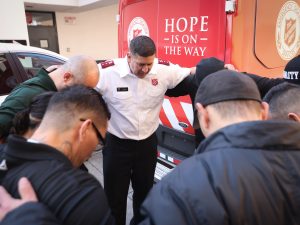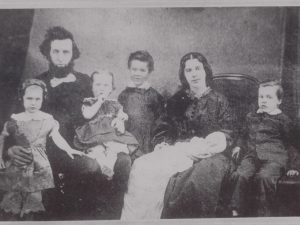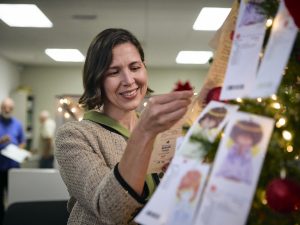It works from the inside out.
It starts with a simple question.
“One of the first things I say to anybody when they contact me is: let’s discuss the purpose of the program you’re running,” said Kendra Holly, a teacher and special needs consultant for The Salvation Army.
That question—and the act of defining purpose—is what inevitably tends to shape the dialogue between pastors, parents, Sunday school teachers and members of the church community when it comes to involving and welcoming those with special needs or disabilities.
An estimated 54 million adults live with a disability in the United States, according to the Center for Disease Control, with an additional 6.5 million children and youth ages 3–21 receiving some form of special education services, according to the National Center for Education Statistics.
The desire to create a more inclusive church with limited resources coupled with the growing need can lead many to feel overwhelmed. But people like Holly and a growing number of free or low cost resources are available to help.
“People feel stressed, like they want to make sure their program is perfect,” she added.
Of course, perfection isn’t the purpose or the end-goal when it comes to worship. It’s about meaning-making, connection, and community. “For The Salvation Army, the real purpose is to know how much God loves us and to give a deeper understanding of that,” Holly said.
Access for all
– Volunteer to serve as an ASL interpreter or to help with special needs kids or adult ministry at your local church. – For special needs resources in The Salvation Army, contact Kendra Holly at special.needs@ – Familiarize yourself with the American Association of People with Disabilities Interfaith Initiative at aapd.com. Also find “That All May Worship: An Interfaith Welcome to People with Disabilities,” a guide to help transform congregations of all faiths into places where children and adults with disabilities are welcomed, honored and enjoyed. Accessing a deeper dialogue with Christ is a worthy goal for all persons—wounded, flawed, able-bodied and disabled alike. The late Rev. Harold Wilke, a United Church of Christ pastor, was instrumental in the movement toward more inclusive churches. He lobbied for the passage of the Americans with Disabilities Act (ADA), which was signed into law by President George H.W. Bush in 1990. This legislation guarantees that individuals with disabilities will not be denied employment or promotion because of their disabilities, and also promises accessibility to transportation services and public accommodations such as restaurants, museums, libraries and parks. While most churches are exempt from ADA, the spirit of the ADA aligns with the standards by which most congregations worship. “That All May Worship: An Interfaith Welcome to People with Disabilities,” a guide published by the American Association of People with Disabilities based on the advocacy work of Wilke and others, offers comprehensive guidelines to help transform congregations of all faiths into places where children and adults with disabilities “are welcomed, honored, and enjoyed.” The ADA is an “enactment in our time of Biblical precepts concerning love of neighbor and respect for all of God’s children,” the guide reads. “The Americans with Disabilities Act reflects the principles of love and justice, which are the underpinnings of a life of faith.” In practical terms, church leaders seeking a more inclusive and welcoming congregation should consider building design and possible accommodations that can be made inside to the sanctuary and classrooms to ensure barriers in terms of sound, sight, physical accessibility and understanding are minimized as much as possible before a need arises. Small changes can make a big difference in the lives of many, and often cost very little or nothing at all. “A church is handicapped unless it has persons with handicapping conditions within it. Only when all of God’s children are present are we truly the body of Christ,” Wilke once said at a conference on disabilities concerns. The notion is rooted in Scripture: “For my house shall be called a house of prayer for all peoples” (Is. 56:7c NRSV). For Julie Sutton, a licensed counselor who works in officer care and development for The Salvation Army, something as simple as a new table makes it possible for her 11-year-old son, Andrew, to attend the Torrance Corps in Southern California with his peers. “He has spina bifida,” she said. “Other than using a wheelchair to get around, he is a typical 11-year-old boy. He has been involved in most of the youth programs that have been offered in our corps.” And while there’s a desire for more specialized programming and an improved ministry for people with disabilities here in the United States, Sutton said every family’s needs are different. But the ethos at The Salvation Army is to “meet people where they are,” said Holly, and that means finding and offering solutions for individuals to participate as usual whenever possible so that specialized programming isn’t necessary. That doesn’t mean the outcome has to be the same for each child, she added. “Maybe he or she isn’t going to get all the right answers, or maybe they won’t memorize all the Bible verses, for example,” she said. “But the hope is they had meaningful time together. They built a relationship with you as the leader. That’s really the focus.” Technology has opened another window for those who may be homebound or who might have transportation limitations, are hearing impaired, or have other difficulties physically making it to church service, but who would like to participate. It also makes access to information and resources easier than ever before. At Reality LA, in Los Angeles, for example, weekly sermons are available for download for free online on the Reality LA website, and church members and guests alike can send prayer requests by text message, which can be done anonymously and without a data plan or internet. “It goes to a team of people who are praying throughout the service and during the week,” said Reality’s Sunday Operations Manager, Doug Rominger. “It’s not a submission form, it’s not a link. You don’t need to walk to a box. We try to make it as easily accessible as possible.” At the Salvation Army, Holly works with corps members and leadership across the country when a need arises by offering resources through an online Lotus Notes portal. “One thing that would be really easy for people to do is to invest in our kids. See them for who they are and love them aside from the disabilities.” –Julie Sutton When she’s working with church leadership, Holly might suggest, for example, small changes in how a Sunday school classroom is set up to help involve a child or adult on the autism spectrum in classroom activities, such as assigning certain teaching or supplies tasks, or helping to pass out bulletins. These “hands on” tasks can provide another level of social interaction before, during or after worship. Rominger and colleague Sarah Frank believe what might be considered deficiencies in terms of accessibility can and should be made up in community. For example, a group who goes to church together at Reality LA helps ensure a friend with epilepsy can attend service each week and is carried to safety if he experiences a seizure. Whether it’s reaching out to a neighbor in need of a ride, providing prayer, volunteering if you have a special skill, or supporting parents when their child or loved one is in the hospital, inclusivity begins at home. Sutton agrees. “One thing that would be really easy for people to do is to invest in our kids,” she said. “See them for who they are and love them aside from the disabilities.” SOURCE: Center for Disease Control, National Center for Education Statistics Sometimes it’s as simple as changing the language we use to help build a more inclusive church from the inside out. “Through our years, we’ve been shifting our language to be more dignity-driven than deficiency-driven,” Frank said, noting Ephesians 2:10: For we are His workmanship, created in Christ Jesus for good works, which God prepared beforehand that we should walk in them (NKJV). Frank said the Greek word for workmanship—“poiema”—signifies that everyone is a masterpiece created for good work, regardless of “ability.” Indeed, good work toward inclusion also means boosting friendships and connections so that no one ever feels alone, Holly said. “No matter who walks through the door,” she said, “we want to give them some sort of resource to make sure each person’s needs are met in a meaningful way.”
usw.salvationarmy.org.
Dignity-driven identity
An estimated 54 million adults live with a disability in the United States, with an additional 6.5 million children and youth ages 3–21 receiving some form of special education services.












